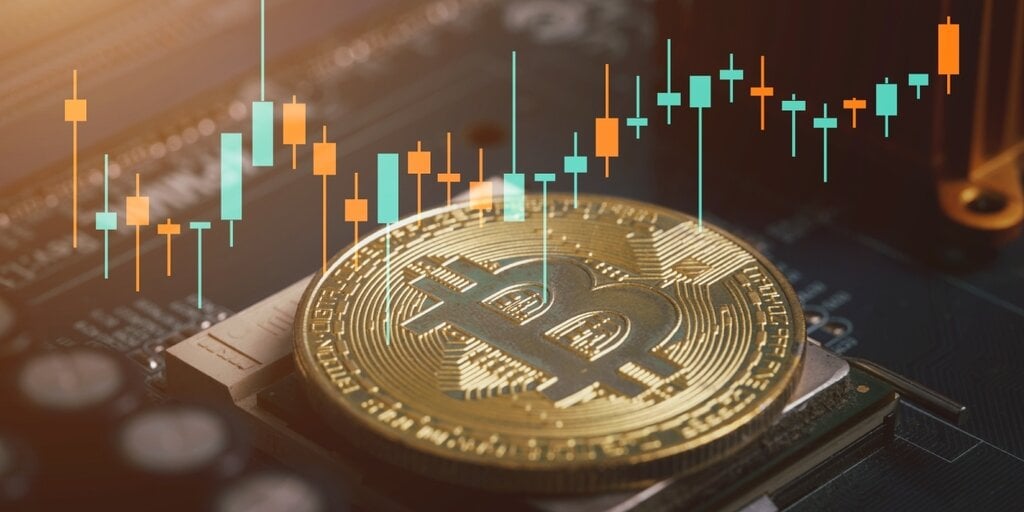In brief
- Institutional investors including sovereign wealth funds drove Bitcoin’s April rally, while retail investors pulled out of ETFs, Coinbase’s John D’Agostino said.
- Bitcoin rose 13% over the month, climbing from $76,500 to near $96,000 before settling above $92,000.
- Institutional demand is tied to de-dollarization, inflation hedging, and a shift away from tech-stock correlations, the exec said.
Institutional interest in Bitcoin intensified last month, even as retail investors reduced their exposure.
That’s the takeaway of John D’Agostino, head of strategy at Coinbase Institutional, who told CNBC Squawk Box that “pools of capital that have been buying during April” included “sovereign wealth funds, large institutional, long term duration pools of capital,” while Bitcoin exchange-traded funds (ETF) saw net outflows.
In April, D’Agostino said, “Bitcoin ETF flows were net negative to the tune of about $470 million.” He added that, “Institutions, sovereigns, patient pools of capital were piling in,” while “retail via the ETF were exiting.”
The price of Bitcoin rose around 13% over the month, outpacing gold’s 10.5% rise and climbing from lows of $76,500 to highs near $96,000. At time of publication, Bitcoin is trading at around $92,800, down 1.3% over the past 24 hours, per data from CoinGecko.
The Coinbase executive said the price action reflects Bitcoin “trading on its core characteristics,” including scarcity, immutability, and portability, traits he likened to gold.
“When you do the work, there’s a very short list of assets that mirror the characteristics of gold. Bitcoin is on that short list,” he said.
Changing institutional behaviour
D’Agostino pointed to three key factors linked to changing institutional behavior: First, de-dollarization: in response to macroeconomic shifts like the April 2 tariff announcements, some governments are preparing for a weaker U.S. dollar.
“If you think dollar is going to weaken, then you don’t [convert Bitcoin to dollars] anymore,” he said, noting how sovereign funds now prefer to hold BTC in local currencies.
Second, D’Agostino said Bitcoin is “no longer trading like a tech stock,” referencing its past bundling with high-growth assets like NVIDIA. “Post-COVID, Bitcoin got caught up in this levered tech trade,” but that narrative is now unwinding.
Third, D’Agostino pointed out that Bitcoin is seen as a long-term inflation hedge, especially by institutions that missed the gold rally.
He acknowledged that some of the best commodity traders he knows include Bitcoin in their inflation-hedge models, saying that in every one of their analyses, “Bitcoin was top five.”
Safe haven, or not yet?
Bitcoin’s recent divergence from equities, rising while the S&P 500 and Nasdaq fell 3% on Monday, sparked debate about whether it’s becoming a “safe haven” like gold.
D’Agostino urged caution about reading too much into recent price behavior, saying, “This is a relatively short-term data set… Be very, very careful,” noting that correlations can shift quickly and shouldn’t be overanalyzed in isolation.
Even so, he acknowledged Bitcoin’s growing role in institutional strategy, “So, again, nothing’s perfect, but as a basket for protecting its market panic and inflation hedge, Bitcoin and gold go side by side.”
Bitcoin’s recent strength may owe more to shifting sentiment than structural change, suggested Nansen CEO and co-founder Alex Svanevik.
“Bitcoin has been surprisingly resilient throughout the trade war, holding up against altcoins and, more recently, against the S&P 500,” Svanevik told Decrypt, pointing to “ongoing positive news flows”—including reports that the U.S. Treasury is exploring ways to move reserves into Bitcoin.
But he cautioned that the asset’s profile hasn’t fundamentally changed, noting that, “Bitcoin remains a risky asset that would be vulnerable if the odds of recession increase.”
The analyst added that while gold may prove more resilient, even that could face “net selling if investors panic to cover margin calls,” as seen during the worst days of the trade war earlier this month.
Daily Debrief Newsletter
Start every day with the top news stories right now, plus original features, a podcast, videos and more.




